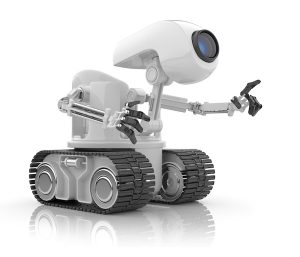Various infrared and thermal-imaging devices help detect covert threats, objects, and suspects. Unlike standard image intensifiers that amplify low levels of light, thermal imagers are more sensitive to infrared (IR) light. Therefore, they are not susceptible to ‘blooming’, which is a condition caused when a bright-light source relative to the surrounding environment is directed at the intensifier, which temporarily blinds it. As a result, industries and government agencies are beginning to increase the use of infrared cameras in reconnaissance robots for threat detection, along with package and object inspection.
Thermal imaging uses cameras that “see” heat instead of light. Sometimes referred to as “FLIR” cameras, they produce an image that portrays objects using their temperature instead of their visible properties.
So how does thermal imaging see heat? All objects warmer than absolute zero (-273°C/-459°F) emit infrared radiation in the MWIR and LWIR wavelengths (3µm–14µm) in an amount proportional to the temperature of the object.
Thermal imaging focuses and detects this radiation, then translates the temperature variations into a greyscale image, using brighter and darker shades of grey to represent hotter and cooler temperatures, which gives a visual representation to the heat profile of the scene. In many cases, infrared cameras can also apply color profiles to the images that are gathered, showing hotter objects as yellow, and cooler objects as blue, for example, to make it easier to compare temperatures in the image.
At Universe Optics, we offer a wide variety of lenses suitable for high-powered surveillance needs and thermal imaging. Should you require a lens to be manufactured with a specific set of parameters, you can be assured that our design and manufacturing team will craft a precision lens to your exact specifications.
Specifically, illuminating cameras, i.e., infrared cameras used in reconnaissance robots are ideal for:
Threat Detection
Thermal cameras are ideal for 24/7 wide area threat detection tasks, especially when combined with video analytics.
- Wide are day/night observation
- Ideal for video analytics
- High detection rate with low false alarms
- Continuous operation day or night
Threat Recognition
Thermal and color/day imaging cameras with zoomable optics, paired with high resolution day imaging cameras, excel at threat recognition and classification tasks.
- Verification of threat type
- Determine vehicle type
- Determine the number of individual threats
Threat Identification
Multi-sensor PTZ (Pan Tilt Zoom) cameras with near-IR illuminators excel at providing threat identification day and night; they can acquire prosecution level video quality at both short and long ranges.
- Determine friend versus foe
- Extremely fine details in zero light
- Read text on objects held in hand
- See through glass
Thermal cameras can also be used to detect fires from a distance of a few feet up to 4 miles away. They can be used to effectively detect flames and hotspots which can enhance the safety and security of any infrastructure, equipment, and personnel. A few places where fire detection is useful include protecting private property, towns, recycling centers, waste management facilities, warehouses, wooded areas, and other critical infrastructures.
Along with the private sector, the IR-imaging market stands on the edge of significant growth as funds from homeland security begin to trickle into specific projects within the federal budget and supplemental war budget. Eventually, these funds will funnel down to the state and local levels.